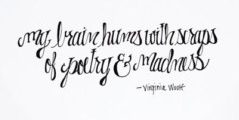Adichie, Chimamanda Ngozi. We should all be feminists. New York: Anchor , 2015. Print.
This short story is included in my bibliography because of the influence of feminist thought. The running theme of a female voice being the voice of power/strength and perspective throughout my poetry speaks to the similar idea that Adichie searches for in her work.
Conron, John. The American landscape; a critical anthology of prose and poetry. New York: Oxford U Press, 1973. Print.
This anthology is important to the influence of my own poetry because of how the use of landscape is used in many of these poems. In this collection, there is Emily Dickinson’s use of nature, as well as many others. This anthology specifically aided in my use of nature as setting the scene.
Cummings, E. E., and Horace Gregory. E.E. Cummings: a selection of poems. New York: Harcourt, Brace Jovanovich, 1965. Print.
In this selection of poems by E.E. Cummings, this has influenced my poetry a lot throughout the years. Cummings has influenced the idea of utilizing space as a substance of the poem, as well as experimenting with repetition. These are two craft choices that run throughout most of Cummings’s poetry as well.
Fisher-Wirth, Ann W. The ecopoetry anthology. San Antonio, TX: Trinity U Press, 2013. Print.
This anthology was used in a class taken at Sweet Briar College: Poetry and the Environment. In this anthology, there were poems that utilize nature in all different ways. I specifically drew a lot from the long poem, “Midnight Oil” by Sheryl St. Germain, “Design” by Robert Frost, and Jane Meade’s, “The Origin.” I took a lot away from this anthology about structure and using nature in a way of extended metaphor and setting landscape as setting for a poem.
Hollander, Andrea. When she named fire: an anthology of contemporary poetry by American women. Pittsburgh, PA: Autumn House Press, 2009. Print.
This anthology of contemporary women writers most likely leads back to the idea of the continuous woman speaker in all my poetry. The poetry in this anthology is also contemporary in its examples for structure and experimenting in poetry. This can be seen most prevalent in the poems with structure experimenting, “As Cruel As I” and “Things Change, and You Leave.”
Hopkins, Ellen, Ellen Hopkins, Ellen Hopkins, and Ellen Hopkins. The crank trilogy. New York: Margaret K. McElderry , 2013. Print.
In this poetry trilogy, I took a lot from this about using space to slow a poem down or speed a poem up. I also was influenced in the idea of writing poetry about substance abuse in combination with relationship.
Kalman, Maira. The principles of uncertainty. New York: Penguin , 2009. Print.
This memoir aids to my concept of memory in short spurts. This book is more like a comic in how it relies on illustrations. This memoir has moments of true beautifully flared language. In these moments, I was influenced in my poetry for ekphrastic poetry, using smooth language to describe an image and idea in one.
Loori, John Daido. The zen of creativity: cultivating your artistic life. New York: Ballantine , 2005. Print.
This is a book that was used for a poetry workshop at Sweet Briar College: Asian Influences. This book influenced the poem “Just Until Morning” and “Loved Me with the Mouth of a Sailor, But Only at Sea.” The book included sections that described the change from haiku beyond and the idea of creating zen in poetry. These poems are influenced from this literature.
Roberts, Josephine A. The poems of Lady Mary Wroth. Baton Rouge: Louisiana State U Press, 2007. Print.
This collection of sonnets has influenced my poetry from her voice speaking of pain. When reading Lady Mary Wroth for the first time, in comparison with the men sonnet writers, she stands out in her power. This idea of power through the female poet’s voice influences my own writing.
Ruefle, Mary. Trances of the blast. Seattle: Wave , 2014. Print.
This poetry collection influenced the poem “Brew Slow.” She often takes a description of something and blows that image or idea up for a poem. I took this idea “Brew Slow” by focusing on two things, something that could be watched slowly (the steam above the coffee) with the complex of the relationship with someone who doesn’t understand the other person (“you make it so hard to read what you are feeling”).
Shakespeare, William, and Katherine Duncan-Jones. Shakespeare’s Sonnets. London: Bloomsbury, 2016. Print.
This sonnet collection encouraged the use of the haiku in “Mama Knows” as well as the couplets that are found throughout several of the poems in the collection. One example in particular, “Planting Seeds in a Storm” and “Night Drunk on You.”
Trethewey, Natasha D. Beyond Katrina: a meditation on the Mississippi Gulf Coast. Athens, GA: U of Georgia Press, 2015. Print.
Trethewey’s use of memoir with poetry combined in one lead to the poem “Mama Knows.” Originally, this poem was not a prose section followed by a haiku. After Trethewey’s book and Shakespeare’s sonnets, they had influenced that poem to be created as a prose into poetry mix.
Woolf, Virginia. Room Of One’s Own. COLLECTORS LIBRARY, 2017. Print.
Virginia’s Woolf’s Room of One’s Own was the first work by Woolf that I ever read. This piece struck me for her descriptive writing that is always right on the nose. After reading more of Woolf, I wanted this amount of vivid imagery and description in my own poetry.
